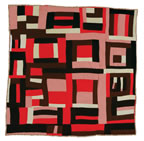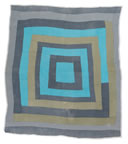Monday, December 1, 2008
My E-Portfolio
Sunday, November 30, 2008
THE WOMEN AND THEIR QUILTS OF GEES BEND


 The twentieth century, making quilts was considered a domestic responsibility for women in Gee's Bend. As young girls, many of the women trained or apprenticed in their craft with their mothers, female relatives, or friends; other quilters, however, have been virtually self-taught. Women with large families often made dozens upon dozens of quilts over the course of their lives.
The twentieth century, making quilts was considered a domestic responsibility for women in Gee's Bend. As young girls, many of the women trained or apprenticed in their craft with their mothers, female relatives, or friends; other quilters, however, have been virtually self-taught. Women with large families often made dozens upon dozens of quilts over the course of their lives.
The women consider the process of "piecing" the quilt "top" to be highly personal. In Gee’s Bend, the top—the side that faces up on the bed—is always pieced by a quilter working alone and reflects a singular artistic vision. The subsequent process of “quilting” the quilt—sewing together the completed top, the batting (stuffing), and the back—is sometimes then performed communally, among small groups of women.
Gee’s Bend today is a small, rural, primarily African-American community in Alabama, whose population numbers approximately 700. Located about 30 miles southwest of Selma inside a horseshoe-shaped bend at the base of the Alabama River, Gee’s Bend is surrounded by water on three sides. The geographic isolation created by the encircling river has marked life there for several generations. Gees Bend has just one road leading out of town, which was not even paved until about thirty-five years ago. The only other physical connection to the outside world was a ferry service leading across the river, which was terminated in the 1960’s.
Until recently, the women of Gee's Bend who made these lasting works of art would never have called themselves artists. They just made the quilts to keep warm. During the civil rights movement they formed a group called the Freedom Quilting Bee. It was a rural collective that produced quilts for eastern department stores. For 30 years the quilting bee provided employment for local black women. In the late 1990's the Quilting Bee ended because many of the members died. But the quilts that Gee's Benders created both at the Quilting Bee and in their homes have a lasting legacy. In the town today, there is only a post office and a grocery store. The residents mostly live in secondhand trailers and old shacks. Many of the young residents moved on to jobs in Birmingham or Mobile. The sadness of the town makes the brilliance of the quilters all the more inspiring.

In Gee's Bend the quilt symbolized practicality, survival, and the use and reuse of materials. A quilter’s designs passed on through generations from mother to daughter. These quilts were heirlooms connecting home and ancestors, who are represented in the quilts by their left behind clothing. As stated by one of the Gees Bend quilters Mensie Lee Pettway, ‘A lot of people make quilts just for your bed to keep you warm. But a quilt is more. It represents safekeeping, it represents beauty, and you can say it represents family history".
There are different names the Gee's Benders have come up with for their quilt patterns. They call the square -in -square log cabin pattern the name "housetop", the Courthouse steps a variation is known as "Bricklayer", the roman stripes or fence rail pattern is a "Crazy Quilt.
We now know a great deal about quilting and the woman of Gee's Bend.
Lesson-
I would like to introduce an activity based on one of the designs used by Loretta Pettway of Gee's Bend. It is called a"housetop" design because the squares represent the elevation of the roof of a house seen from above. Just like a bird's eye view Mapmakers show the various heights of land in different colors. We are going to make a topographical map of the classroom. {or your room}. Things in the room that are different heights will be represented by different colors on your map. The map will not show everything, just the major pieces of furniture. Measure the height of the major pieces of furniture such as desks, chairs, bookshelves etc. Record these measurements on a piece of graph paper. Draw the map of the classroom on a piece of white paper. Refer back to your recorded measurements. Color all the objects including the floor according to the following:
Mapmakers show the various heights of land in different colors. We are going to make a topographical map of the classroom. {or your room}. Things in the room that are different heights will be represented by different colors on your map. The map will not show everything, just the major pieces of furniture. Measure the height of the major pieces of furniture such as desks, chairs, bookshelves etc. Record these measurements on a piece of graph paper. Draw the map of the classroom on a piece of white paper. Refer back to your recorded measurements. Color all the objects including the floor according to the following:
0-1 feet high = color 1
1-2 feet high= color 2
2-3 feet high= color 3
3-4 feet high= color 4
4-5 feet high = color 5
5 feet and higher = color 6
Some questions to think about after the activity is complete:
Does your map remind you of the quilts?
In what ways?
Would you consider your map to be a quilt?
Why or why not?
Here are two links to click on and meet people of Gees Bend :
link one The Quilters of Gee's bend Alabama clip 3
link two The Quilters of Gee's Bend clip 1
Wednesday, November 19, 2008
WISH YOU WERE HERE


Instructor- Amy DeLeo Grade Level- sixth grade Subject – Your neighborhood
Title: Wish You Were Here
Brief History / Background-
My neighborhood is Bucks County Pennsylvania. I have been living here sixteen years. What makes this area so special to me is, I live in the country were there are horses, cows and, farms. The special part about living here is that you see all this around you and you are still very close to two cities they are New York and Center City Philadelphia. I feel very lucky to live here. I have the best of two worlds.
PA Academic Standards:
9.1.6.B- Recognize, know, use and demonstrate a variety of appropriate arts elements and principles to produce, review, and revise original works of art.
9.1.6.E- Know and demonstrate how arts can communicate experiences, stories or emotions through the production of works in the arts.
9.2.6.G- Relate works in the arts to geographic regions
Goal- To create a collage that represents your home, neighborhood or culture
Objectives- Students Will-
1-Learn how to represent their neighborhood in collage form.
2-Learn how to use a digital camera
3- learn about collage techniques
4- Learn how to transfer what they like about their home town to a collage form
5- Learn about composition in a collage
Resource materials:
I will show examples of collages that have been done of different areas.
I will show the collage I did of my neighborhood
Supplies-
Digital cameras, 8x10 paper,Glue,Scissors
Teacher Preparation: Gather supplies, make an example, make a teaching board, Gather books on collages
Directions:
1- Students will take the digital cameras home and take pictures for their collage.
2- Students will bring in the photographs they want to use for their collage
3- Students will cut the photographs and arrange them on an 8x10 paper
4- Students will glue the arrangement onto the paper
Closure-
Students will clean up their area and put the supplies away.
We will put all the collage pieces on the board and discuss them.
Time Budget:
The first class I will introduce the lesson and hand out the cameras
The second class
20 Minute work time
10 minute clean up
10 minute critique and discussion
Vocabulary-
Collage- Introduced by Cubists, the technique of creating a work of art by adhering flat articles such as paper to a flat surface whereby a three dimensional result is achieved.
Cubism- an art style developed in 1908 by Picasso and Braque whereby the artist breaks down the natural forms of the subject into geometric shapes and creates a new kind of pictorial space.
Safety concerns: N/A
Wednesday, October 15, 2008
Your Culture Quilt

Instructor- Amy DeLeo
Grade Level- Eighth Grade Subject- Quilts Title: Your Culture Quilt
Brief History / Background-
Throughout history, women and sometimes men have used the art of quilting for many diverse purposes: to keep warm, to decorate their homes, to express their political views, to remember a loved one. Made by hand- often collaboratively using familiar materials such as scraps of clothing, quilts are personal and communal, aesthetic and functional. Quilting continues to be a largely a home- based form of art engaged in primarily by women. Quilts reflect the lives of the people who create them. Quilts record the cultural history of a particular place and time.
PA Academic Standards:
9.1.6.B- Recognize, know, use and demonstrate a variety of appropriate arts elements and principles to produce, review, and revise original works of art.
9.1.6.E- Know and demonstrate how arts can communicate experiences, stories or emotions through the production of works in the arts.
9.2.6.G- Relate works in the arts to geographic regions
Goal- to create a quilt that represents the culture of the entire class
Objectives- Students Will-
1- Define what a quilt is and describe some of the historic purposes and uses of quilts.
2-Learn how this type of quilt was used historically.
4- Learn to identify elements in quilts, such as colors, shapes, patterns, and symbols.
5- Learn how quilts can be objects of both everyday use and artistic expression.
Resource materials:
I will show a slide show of examples of quilts from different cultures
I will discuss the meaning of the quilts
I will show the various types of designs used in quilts
Supplies:
Pieces of your old clothing that represent you
Thread
Needles
Backing
Cotton/polyester stuffing
Teacher Preparation: Gather supplies, make an example, make a teaching board, Gather books on quilting Show the slide presentation on various types of quilts
Directions:
1- Students will design a 12x 12 square out of the clothing pieces they want to use for their part of the quilt.
2- Students will gather all the squares lay them out and design the entire quilt
3- Students will pin the squares together and we will sew them all together
4- Once they are all sewn together we will learn how to put the stuffing in and attach the backing
Time Budget:
The first class I will introduce the lesson. I will also show slides with examples of quilts from many cultures.
The second class
20- Minute work time to work on their individual squares
10 -minute clean up
10-minute critique and discussion
The third class-
We will design how the quilt should be put together and begin to sew the squares together
The fourth class-
We will finish up the sewing and put stuffing in and sew the back
The fifth class-
We will critique and discuss our class project and what was learned about quilting
Vocabulary-
Quilt- an item of bedding consisting of two layers of fabric stitched together with a warm stuffing in between, often having a decorative design.
Story Quilt- Depicts bible stories
Patriotic Quilt- national symbols such as stars and stripes were used in American quilts throughout the 19th century
Grooms Quilt- A family record quilt
Friendship Quilt-These are quilts that are made to be given to friends often containing dates signatures and verses.
Safety concerns: be careful with the scissors, needles and pins


